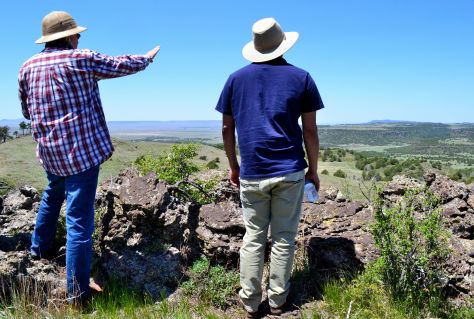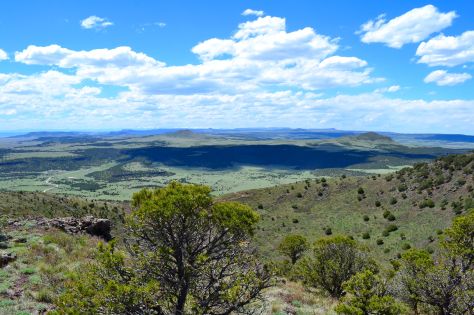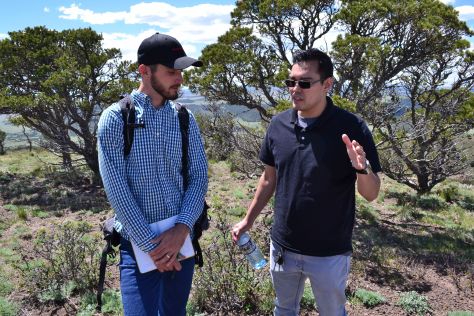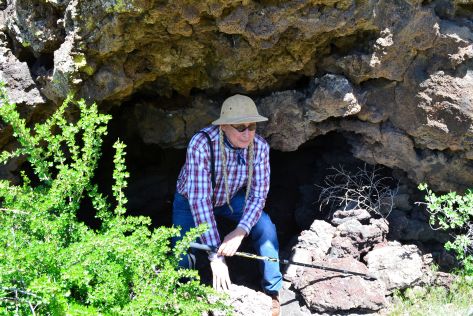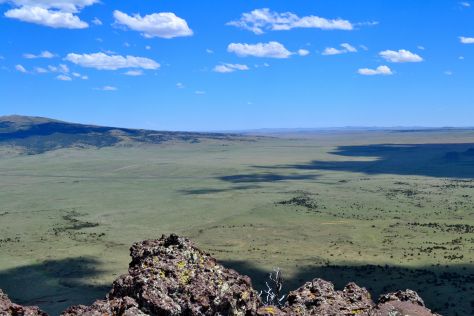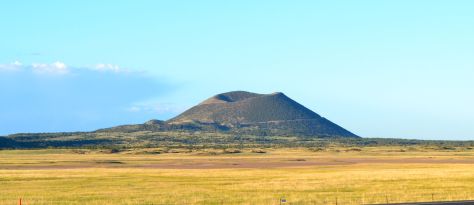
The lands that lay beyond the Mountain That Touches the Sky seemed made of a dry kind of green, a distant realm surrounded by receding mountains. I had never visited this part of Colorado. For many years I had peered down along the High Plains, south to where the Mountain stood, wondering.
Years ago, studying certain matters of the ancient past, I had decided that my ancestors had once dwelt there in the south, and I wondered what kind of world it might be. I had the thought that someday I would visit. Now I was floating across an arid green world; remote mountains hovered here and there.
Along the way I thought of Jack Kerouac’s famous novel, On the Road. He drove here in 1950 and made brief mention of his friend, archaeologist Hal Chase, who was “somewhere off the road in front of a campfire with perhaps a handful of anthropologists[.]” Chase conducted excavations during that time at the Snake Blakeslee site, an Apishapa phase community. About 800 years ago the realm of the Apishapa phase unfolded south of the Mountain That Touches the Sky, stretching down into northern New Mexico.
It was probably sometime in the 15th century that the Apishapa phase population moved into the plains, flowing into the folk whose descendants became the Pawnees and other related peoples. I believe we can glimpse memories of this history in certain Pawnee oral traditions. And later generations of Pawnee travelers knew those traditions, and they had come back to this land, journeying in search of trade and treasure and training, stealing horses, stalking enemies, looking for adventure.
Turning east onto Highway 64 in New Mexico I skirted the edges of an ancient volcanic field. I was soon driving through millions of years of slowly disintegrating lava flows and fading volcanic cones. Herds of pronghorns and deer stood on the crumbling basalt. Over the next two days I saw various animals galloping over this terrain, and I wondered how they did it, their hooves clattering on stony soils made of sharp corners. I had to walk carefully on the stuff. But all through the years as wind and ice did their magic, the stones slowly melted into rich soils and healthy vegetation.
I soon came upon Capulin Volcano National Monument. I stopped my car and got out to look. A lonely mountain capped with a vegetated caldera stood alone north of the road. I took a photo and drove on to the Mandala Center. There I found John Micheal Knife Chief and Walter Echo-Hawk.
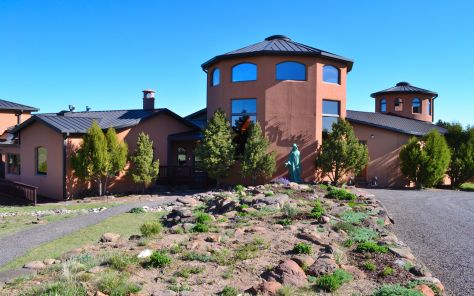
The National Park Service had invited the Pawnee Nation to send a delegation to consult with them about Pawnee connections to the region – John Micheal serves as the Tribal Historic Preservation Officer and he had asked Walter and me to join him. The next morning dawned (May 24, 2016), and we met with NPS staff and two consultants from Parametrix. We spent the morning talking about Pawnee history in the region.
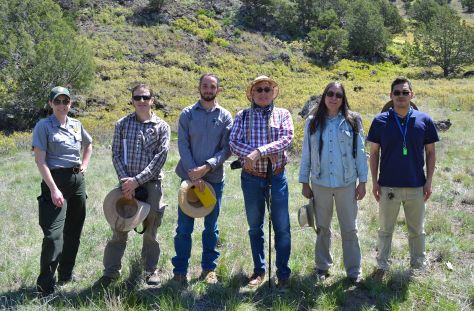
May 25, 2016: Lynn Cartmell (NPS CAVO Lead Park Ranger), Shawn Kelley (Parametrix Senior Cultural Anthropologist), Sean O’Meara (Parametrix Ethnographer / Ethnobotanist), Walter Echo-Hawk, Roger Echo-Hawk, John Micheal Knife Chief (Pawnee Nation Tribal Historic Preservation Officer); photo taken by Zach Cartmell (NPS CAVO Park Natural Resource Manager)
Capulin Volcano crouches at the southern edge of the region occupied by the Apishapa phase people. At the northern edge of this realm stands Toos Peh, the Mountain That Touches the Sky. I learned the Pawnee name and its translation from very obscure records provided by a friend, and then I found various traditions that made mention of a place where the earth and sky meet, a place where this world connects to another unseen world. Since some of the stories make reference to the origin of corn agriculture, the stories tend to point to the era of the Apishapa phase.
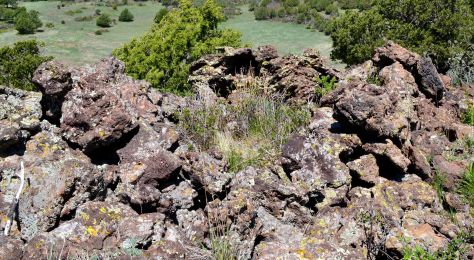
In the course of our visit, the NPS rangers showed us a handful of small mysterious masonry structures. No date could be attached to them, but they do vaguely evoke Apishapa architecture. And at another nearby site someone found a beautifully made side-notched lithic projectile point of a type common in Apishapa sites. A handful of miles to the north of Capulin Volcano can be found a few other sites in New Mexico identified as Apishapa phase occupations.
Various versions of a Pawnee migration tradition were set down between 1866 and circa 1970. The stories are brief and vague, but they mention the southwest, the Rio Grande River, New Mexico, and houses made of stone or stone and mud. The people had sacred bundles in that far land, and they had flint knives and flint arrow points. And when they left that land, the journey took them through mountains into the grasslands – the stories mention how their lodge poles left grooves in the stone. This all happened long ago.
A match for these glimpses of ancient times can be found in the archaeology of the Apishapa phase. The geography of Pawnee tradition points to the Apishapa occupation area, and Apishapa houses and the houses of Pawnee tradition both utilized stone. These are significant conjunctions. But to see a connection between the oral traditions and the archaeological record, we must be willing to accept that it is possible for historical information to endure over a six hundred year period.
It seems logical that this unusual mountain would draw Apishapa visitors. Vague connections between Capulin Volcano and Apishapa are suggested by the stone enclosures and by the side-notched point – it is a type that one report describes as “ubiquitous” in Apishapa sites. Another minor speculative point could also be made. Pawnee tradition recalls how travelers used dog travois transport and there were so many people on the migration that they left grooves in the stone. In the volcanic soils of northern New Mexico travois poles probably did leave visible trackways across well-traveled stony surfaces, and this could have become set in tradition as grooves in stone.
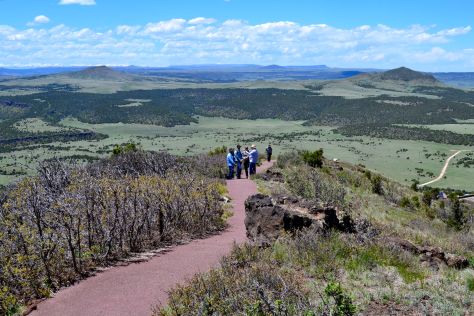
High above that vanished world, a paved path encircles the caldera of Capulin Volcano. Our walk was very windy, but the panoramic view from the rim of the volcano was impressive. The evidence for an Apishapa presence here is slight, and yet… there must have been visitors in that time and later. And how can they not have felt a sense of wonder as they stood here on this mountain, absorbing the magic of the southern circles of their world?
At the northern edge of the Apishapa homeland we find the majestic ramparts of the Mountain That Touches the Sky – an almost forgotten holy place. That mountain lingers in stories as an old religious site, a place of spiritual symbolism. We do not know of other similar holy places in the ancient southwestern ancestral Pawnee homeland, but the unique visual silhouette of Capulin Volcano stands out. Here at the southern edge of the Apishapa realm, surely this enchanted place meant something to my ancestors long ago.
